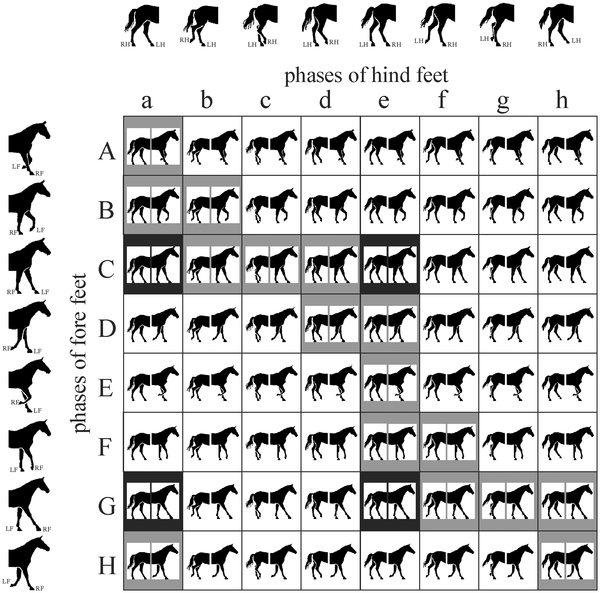I was going to write a post on an interesting paper about genetic variation in the USA but I’ll save it for another day as I found this gem.
A research group in Hungary have found the time to judge who is the best at drawing animals, cavemen or modern artists. Amazingly they found cavemen won the competition! To be fair, what amazes me is that these people came up with this research in the first place. How and why do they have the time to sift through a thousand images and then do a statistical analysis to find which group had the greatest error?
Nevertheless, I’ve learnt something new today. Apparently four legged animals walk in the following way:
The usual succession of the ground-contacting feet of walking quadrupeds, termed as foot-fall formula, is -LH-LF-RH-RF-, where L/R and H/F mean left/right and hind/fore, respectively.
As an illustration the authors provide this figure, follow the grey boxes and you should see what an equestrian gait (how a horse walks) should be like:
So what were the findings? Well apparently Cavemen had a bit more than half the error rate compared to artists pre-1880’s (the gait of four legged animals was described scientifically in the 1880’s). That’s an error rate of 46.2% for cavemen vs. 83.5% for artists such as Da Vinci. More to the point we would have assumed that after describing how animals walked to the world, artists would get a lot better, and they did. However the error rate was still at 57.9%, that’s below the error rate of chance (73.3%, apparently Da Vinci’s contemporary’s would have done better to guess how animals walked), however it is still more than 10% worse off than cavemen. That said this includes taxidermy records, anatomical drawings and modern artistry. The latter being the least reliable by another 10%.
So after doing this, fairly odd and abstract research, we can’t help but ask, why are cavemen better? One person who saw this article has suggested that it is to do with the importance of hunting prey and studying the animal you wish to eat. Whilst I agree that we do less hunting nowadays and animal patterns are less important, we do also keep many of these animals enclosed in farms where we can stare at them readily for days on end and we do have a scientific description of how they walk. Any artist who wants to draw an accurate depiction nowadays just needs to use Google, or sit in a field for a day.
So I’m left with two mind boggling questions. Firstly, why are cavemen more pedantic about animal gait then modern humans? And secondly, why has this made it into one of the biggest science journals? Why not getting smarter by eating chocolate? or fecal tansplants?
Beats me.
EDIT: In response to the comments below I’ve run through the Methods section of this paper (and the supplementary info) and found several caveman sized holes in the work. First off, the sample size for the cavemen drawings is only 39. That’s not too small in some types of research, but compared to 961 drawings from the more modern era, it’s minuscule. This obviously could create some bias and skew the results. However, even worse, as pointed out to me by EvoAnth these 39 paintings could all have been drawn by only a select few people as the source material was extremely limited (from what I can see they only found images on two websites, at least one of which only had pictures from a single cave). Comparing a few cavemen to hundreds of artists is simply not realistic. Oh and Wikipedia was also used as a source, I’ve complained about this already here!
Finally they made a fairly large assumption of where the cavemen were drawing the animals feet. Because they don’t know where the artists were placing the feet. Which is what this whole study was about… Still, why did this paper get published?
Horvath G, Farkas E, Boncz I, Blaho M, & Kriska G (2012). Cavemen were better at depicting quadruped walking than modern artists: erroneous walking illustrations in the fine arts from prehistory to today. PloS one, 7 (12) PMID: 23227149






Adam Benton
/ 18/12/2012I’m wary of the sample. Nowhere in the paper could I find an exhaustive list of where they got their images from. Further, the sample of prehistoric art examined was horrifically small: only 39 images. That could’ve come from one or two sites, which may have been painted by only a handful of individuals (some caves were only decorated by one guy, or one guy and his “students”) making the actual finding of this study “that one guy from Lauscaux was pretty good.”
Except we can’t conclude that because they don’t say where they got the data from. Pretty shoddy work, imo.
Nick Sarbiscuit
/ 19/12/2012I just gave the paper a more thorough read and managed to find the N number (embedded in the supplementary information, probably showing you how embarrassed they were by the number). You are right, 39 vs. 961 is pretty shoddy and completely biased.
In reference to where the data came from :
Firstly, wikipedia? and secondly, considering most of these will be more modern, Lascaux may be a major contributor to the 39.
Also:
That’s a fairly big assumption IMO.
I’ll change the post to adapt to what we’ve said, and I’ll go through the methods section in more detail from now on. I’m too used to the Abstract-Figures-Results approach of reading papers.
To be fair though this just enhances my point, why has this paper been published in PLOS one?